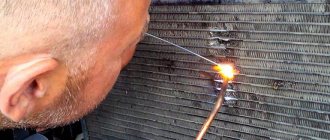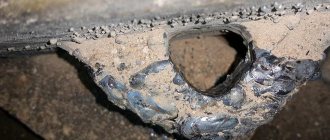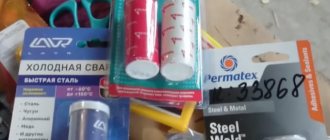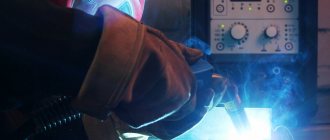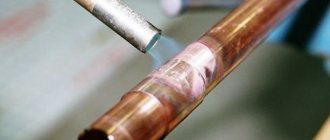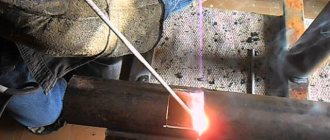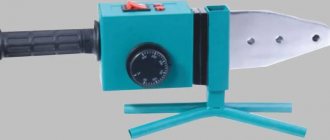During construction and repair, situations arise when it is impossible to connect metal structures and parts with a weld at high temperatures. An alternative option for obtaining a reliable fastening is cold welding. A detailed acquaintance with the characteristics of the materials used and the technology of the work will help you understand the reasons for the popularity of the method.
What is the welding composition, characteristics and types
The basis for adhesion of metal parts to each other is a special glue. It is a plastic mass that penetrates deeply into the metal. Under the influence of the constituent components, the oxide film is destroyed and a strong crystal lattice is formed. The gluing process is similar to pressure welding. The technology is used to join non-ferrous, ferrous and stainless metals.
Composition of adhesive composites
Cold welding ingredients affect the strength of the seam, the hardening time, and the temperature parameters that it can withstand. The scope of its application depends on the composition of the mixture. The basis of glue from various manufacturers is:
- Epoxy resin. A component that ensures homogeneity of the structure, adhesion of the particles of the composition, and its plasticity.
- Hardeners. Substances that accelerate polymerization and hardening of glue.
- Fillers. Metal or mineral powders that increase weld strength, impact resistance, and holding temperature.
- Plasticizers. Ingredients that impart plasticity and increase resistance to shock and mechanical stress.
Work with each individual type of glue must be carried out in accordance with the technological instructions. Operation of treated objects must be carried out in compliance with the conditions recommended by the manufacturer.
Types of cold welding for metal
The consistency of welding glue can be liquid or solid. In the first case, the product consists of two components that are mixed with each other before use. Solid adhesive mass is sold in the form of a homogeneous or two-layer paste. Both compositions form a strong bond after drying.
Depending on the scope of application, cold welding comes in four types:
- Universal. An adhesive containing polymers. The material is suitable for adhesion of metal, plastic, rubber surfaces.
- Automotive. A composite designed for sealing cracks and eliminating minor damage to metal parts of vehicles.
- High temperature. Welding characterized by increased toughness and resistance to high temperatures. After hardening, the weld seam can withstand temperatures from -60°C to +1500°C.
- Water resistant. This type of glue has a two-component composition that does not lose strength when constantly in water. It is an ideal material for repairing communication networks.
The finished gluing mixture quickly becomes unsuitable for use. Therefore, it is not advisable to make blanks in large quantities before starting work.
Depending on the purpose and place of application, the composite can be:
- Spot. Used to eliminate small gaps and weld small parts to large objects.
- Suture. For repairing sealed thin-walled containers and vessels.
- Tavrovy. Used for fixing studs, transformer windings, busbars.
- Stykova. Used for welding wires, closing ends, forming rings.
- Shear welding. Suitable for repairing water pipes and heating system pipes.
The composition of the adhesive determines the ability of the weld to withstand a certain temperature range. These values are indicated on the product packaging. Compliance with the permissible minimum and maximum parameters guarantees the strength and reliability of the fastening.
Point technology
This technology, which involves overlapping aluminum parts, is the most common method of cold welding of this metal. The workpieces to be joined are compressed at individual welding points, for which a special punch is used. According to this technology, parts are predominantly connected by several welding points located at a certain interval relative to each other.
Read also: Why is a transistor needed in an electrical circuit?
Cold spot welding diagram
The quality of cold welding performed using spot technology directly depends on the degree of deformation of aluminum in the area of the weld spot. In numerical terms, this parameter characterizes the relationship between the thickness of the parts being connected and the depth to which the punch is pressed into the metal. There are standards according to which this parameter for aluminum should be 60–70%, and for alloys based on this metal – 75–90%.
Cold spot welding, which can be used to join fairly large sheets of aluminum and alloys based on this metal, has a number of advantages.
- The parts to be connected do not require preliminary fixation in special clamping devices.
- Aluminum is deformed in very small local areas - weld points.
If you have a mechanical device capable of creating significant pressure, cold welding using this technology can be performed at home.
Features of cold welding for aluminum
Connecting workpieces made of this metal with nuts and bolts does not always form a strong fastening. In cases where it is not possible to use electric arc welding, aluminum blanks are held together with special adhesives. With their help, a reliable weld is formed quickly and efficiently.
This method allows you to quickly and efficiently obtain a permanent connection without preparation. Its use is relevant for eliminating emergency situations and breakdowns.
Aluminum glue is available in the form of a mastic or a thick liquid. It includes:
- epoxy adhesive base;
- washing powder that strengthens the connection;
- special additives that increase resistance to high temperatures and aggressive environments.
The components contained in the mastic give the hardened coating increased strength. The weld seam is stronger than the metal itself.
After completing the work, it is necessary to thoroughly clean the tool and the place where the aluminum surfaces are welded from excess glue. It is very difficult to get rid of excess and sagging material after drying.
Butt method
When using this cold welding method, aluminum parts are connected by their end parts, which are first thoroughly cleaned and degreased. In order to make a connection using this method, the workpieces are fixed in special jaws with a small release of the end parts, which will be subject to compression. After the parts are securely fixed, axial pressure is applied to the clamping jaws, which compresses the end parts of the workpieces being connected, which is accompanied by the formation of a reliable permanent connection.
Scheme of butt cold deformation welding
This cold welding method, despite its simplicity, has a number of significant disadvantages and limitations in application.
- The dimensions of the clamping devices used to perform such welding limit the length of the joint formed.
- When aluminum parts are compressed, not only the ends being connected are subjected to plastic deformation, but also the part that is clamped in the jaws.
- After obtaining a permanent connection, the workpieces are quite difficult to remove from the clamping jaws.
Heat Resistant Cold Welding for Metal
High-temperature adhesives are widely used in industrial applications and for household repairs. The main difference between heat-resistant adhesive is the ability to form a seam that can withstand temperatures above 1000°C. The components included in the mixture improve the performance characteristics of the material. When exposed to extremely high temperatures, the strength of the welded joint increases.
The composite goes on sale in finished form. No special preparation or mixing is required before use. The hardened surface is resistant to corrosion and aggressive environments. The gluing areas can be easily sanded.
When choosing an adhesive composition, it is necessary to take into account the melting temperature of the metal itself. It makes no sense to buy glue with a heat resistance that exceeds this indicator for the parts being processed.
Point technology
With this cold welding method, aluminum sheets can be overlapped. It is considered the most popular technology of the three presented. Bonding process:
- The parts are placed on top of each other and pressed on both sides with special clamps.
- The punches are located at a certain interval, to which the precision pressure will be transferred.
- A force is transmitted to the punches, which presses them into the metal.
The strength of the connection will depend on how hard the punch is pressed into the metal and what material these point elements are made of. Also important is the number of points in the connecting line.
The main advantage of spot cold welding is low deformation of the part. It occurs only at the points of contact of the elements through which pressure is transmitted to the aluminum.
How to choose cold welding for metal
A competent approach to the selection of composite material is the key to obtaining a reliable weld. Please check the following specifications before purchasing:
- type of surfaces to be welded;
- minimum and maximum temperature limits suitable for operation;
- best before date;
- the time required to carry out the work;
- period of complete hardening of the composite.
The glue is sold in packages of various sizes and volumes. Material consumption is calculated based on the minimum permissible density of application of the composition.
Suture method
An effective cold welding technique that involves creating a continuous seam using special equipment.
It consists of two rollers, between which parts are secured. The rollers are located parallel to each other. Punches or a special ring are attached to their working part. These elements form the joining seam. Seam welding can be divided into two types:
- One-sided - one roller rotates, the other is firmly fixed in one position.
- Double-sided - two rollers are driven by electric motors.
The process of fastening metal sheets:
- The area that will be fastened is initially degreased and cleaned of dirt and rust.
- The parts are pressed between the rollers.
- After the engine starts, they begin to rotate and drive parts through the working part. This results in a smooth, uniform seam.
Metallurgists often join large sheets of aluminum and other non-ferrous metals in this way. However, it must be remembered that continuous seams reduce the strength of the overall part. Because of this, the suture technique has been modernized over time. In the process of technology development, the point-suture connection method appeared. It involves installing punches on rollers, which make the seam divided into many points. This way it turns out much stronger.
Read also: How to properly harden a spring
Best Cold Welding for Metal
Different brands of glue contain the same base. The main difference is the modifiers and plasticizers that are used by manufacturers. Domestic composites deserve attention no less than foreign materials. The following brands have gained popularity among consumers:
- "Contact". Two-component cold welding of polyepoxy resin and hardener. With its help, the shape of the object being processed is restored, cavities are eliminated and joints are sealed. Adhesive plasticine is resistant to water, solvents and petroleum products. The material is sold in ready-to-use form. In addition to metals and alloys, it glues: glass, wood, porcelain, stone, concrete, hard PVC, soft plastics. The weld seam can withstand operation at temperatures from -30°C to +160°C.
- Hi-Gear or "Fast Steel". The product, made in the USA, consists of two components, which include metal powder. The hardened surface of the composite is resistant to temperatures up to +260°C and aggressive environments.
- "Metal plasticine aluminum polymer." High viscosity adhesive contains fine aluminum dust. The material is characterized by high adhesion to non-ferrous metals, resistance to water, antifreeze and gasoline. It is used for welding high-alloy stainless steels, aluminum, brass and copper.
- "Epoxy titanium". Particularly durable composite with adjustable elasticity. It is used for joining: metal, ceramics, granite, plastic, wood. With its help, cracks, holes in pipelines, radiators, and fasteners are reliably sealed. The shear strength of a frozen seam is more than 30 MPa. This allows welding of objects subject to vibration, bending and shock loads.
Which is better, liquid or plastic form?
There is practically no difference in composition; the main components are the same everywhere. The only differences are in modifiers and plasticizers. As for the question of using some form, each consumer decides for himself based on his own or someone else’s experience.
For me personally, the plasticine format is more convenient. I’m unlikely to be mistaken if I say that craftsmen also prefer this type, but if necessary, I use liquid packaging. Both species have the right to life. The plastic consistency has excellent adhesion, the liquid penetrates deeply into micropores.
Based on specific conditions, you need to carefully select a composition for restoring nodes. It should be mentioned that types of putty are also used for the restoration of car bodies, which are positioned as cold welding for metal.
The time for working with the finished product is limited in all cases, no more than 15 minutes. The product is ready in a minimum of a few hours and a maximum of a day.
Instructions for cold welding for metal
Glue manufacturers are required to include instructions for use with their product. Before starting work, you must read the recommendations specified in it. The general scheme for welding of any grade consists of the following stages:
- The gluing area is cleaned with sandpaper.
- Metal surfaces are degreased with alcohol or acetone.
- The composite is prepared for work. If the glue is two-component and is in different tubes, their contents are mixed in separate containers.
- The adhesive mass is applied to the welding site and pressed tightly.
- The hardened surface is ground.
It is recommended to apply the composite in stages, in several layers. This helps to increase the strength of the connection.
Weicon Repair Stick ST Aluminum. Repair rod
Weicon Repair Stick ST Aluminum is a repair stick that is used to repair plumbing pipes, repair visual damage to the trim of ships, boats, cars and window frames. The rod consists of epoxy resin with copper filler. Refers to repair sticks.
Weicon Repair Stick ST Aluminum Cold Welding Steps:
- The surface of the parts to be joined is cleaned of dirt, treated with sandpaper, and degreased.
- Using a stationery knife, you need to cut off the required part from the rod, wet your hands and knead the glue in your fingers.
- Apply to the broken part and press for 20 minutes.
It is advisable to continue working with the glued product after a day.
- At 20 degrees, the pot life of the composition is 4 minutes.
- Resistant to temperatures from -50 to +120° C.
- Total curing time is 24 hours.
You can work with the adhesive from +10 to +35° C.
The secret behind the popularity of cold welding
This is a universal tool for repair work in the home and industrial sphere. Advantages of using special glue:
- ease of use;
- resistance of the resulting compound to corrosion and aggressive environments;
- compliance with environmental safety standards;
- saving gas and electricity costs;
- surface hardening within 3 hours;
- no waste after completion of work;
- pliability to sand treatment.
In order to carry out cold welding, no additional equipment or professional training is required.
Butt method
This technique is one of the most reliable in terms of cold welding of aluminum. Suitable for connecting parts through their ends. This way you can combine the plates into one large shield. The process of metal bonding occurs in several stages:
- First of all, the ends of the parts are cleaned. Paint, rust and dirt are removed from them. Next they are degreased.
- After cleaning, the parts are clamped in a special vice located opposite each other. Only the ends and 1 cm of metal should stick out.
- When the workpieces are securely fastened in a vice, end pressure is transmitted through them to the ends. With its help, a reliable connection is obtained.
Technologically, this is a simple and low-cost process that is accessible to any craftsman working with metal. However, it has significant drawbacks.
Firstly, the size of the holding vice does not allow the use of large parts for joining. Secondly, part of the metal clamped in a vice is also subject to deformation. Thirdly, after cold butt welding is completed, it is difficult to remove the finished part from the clamps.
Criterias of choice
To choose the right adhesive for gluing metal to metal or other materials, you need to evaluate:
- dimensions of the treated surface;
- properties and composition of the connecting agent;
- drying speed;
- physical and mechanical parameters.
Valera
The voice of the construction guru
Ask a Question
It is important to consider the differences between the surfaces being joined. If the fastening occurs between solid materials, it is better to purchase a hard glue; if attached to an elastic one, it is better to purchase liquid or soft glue.
